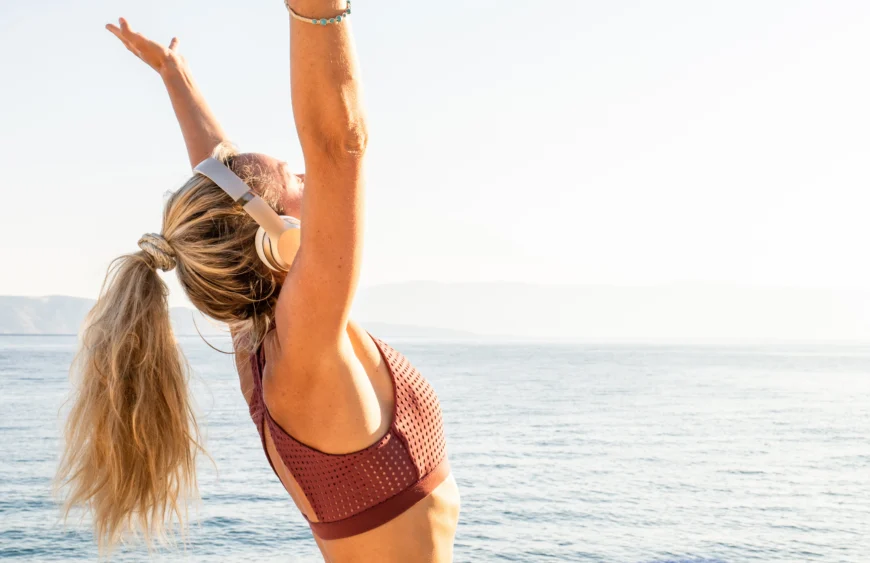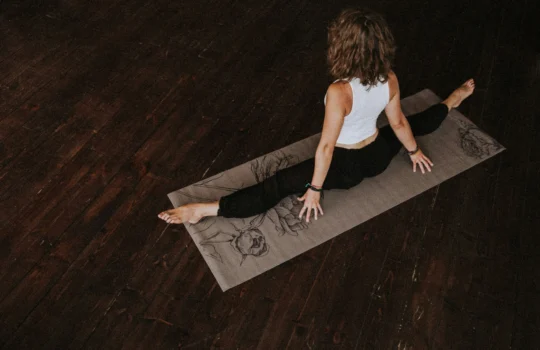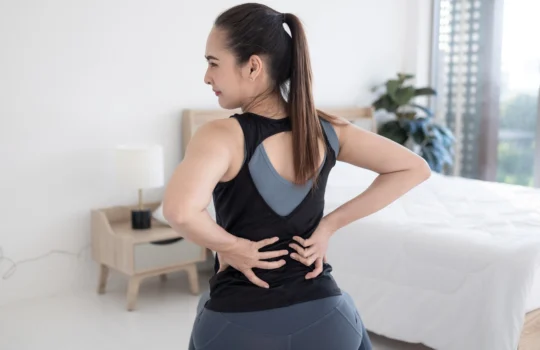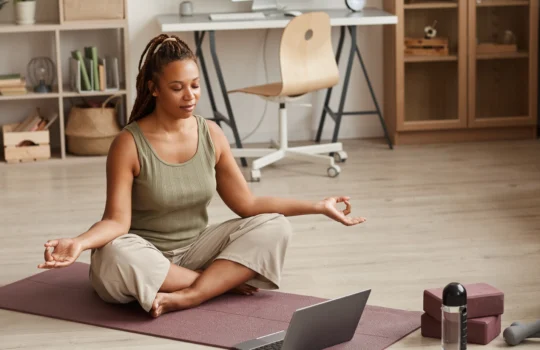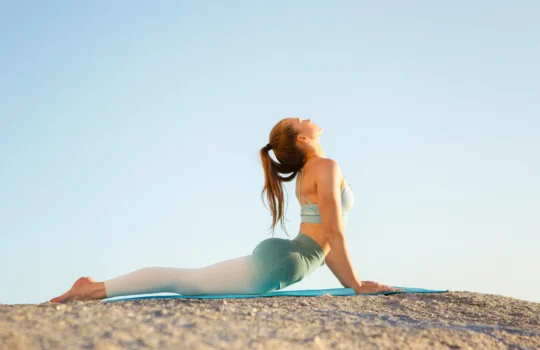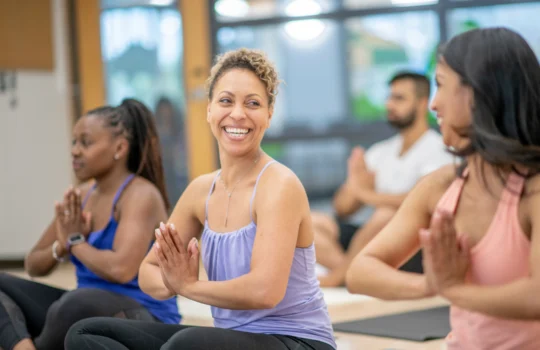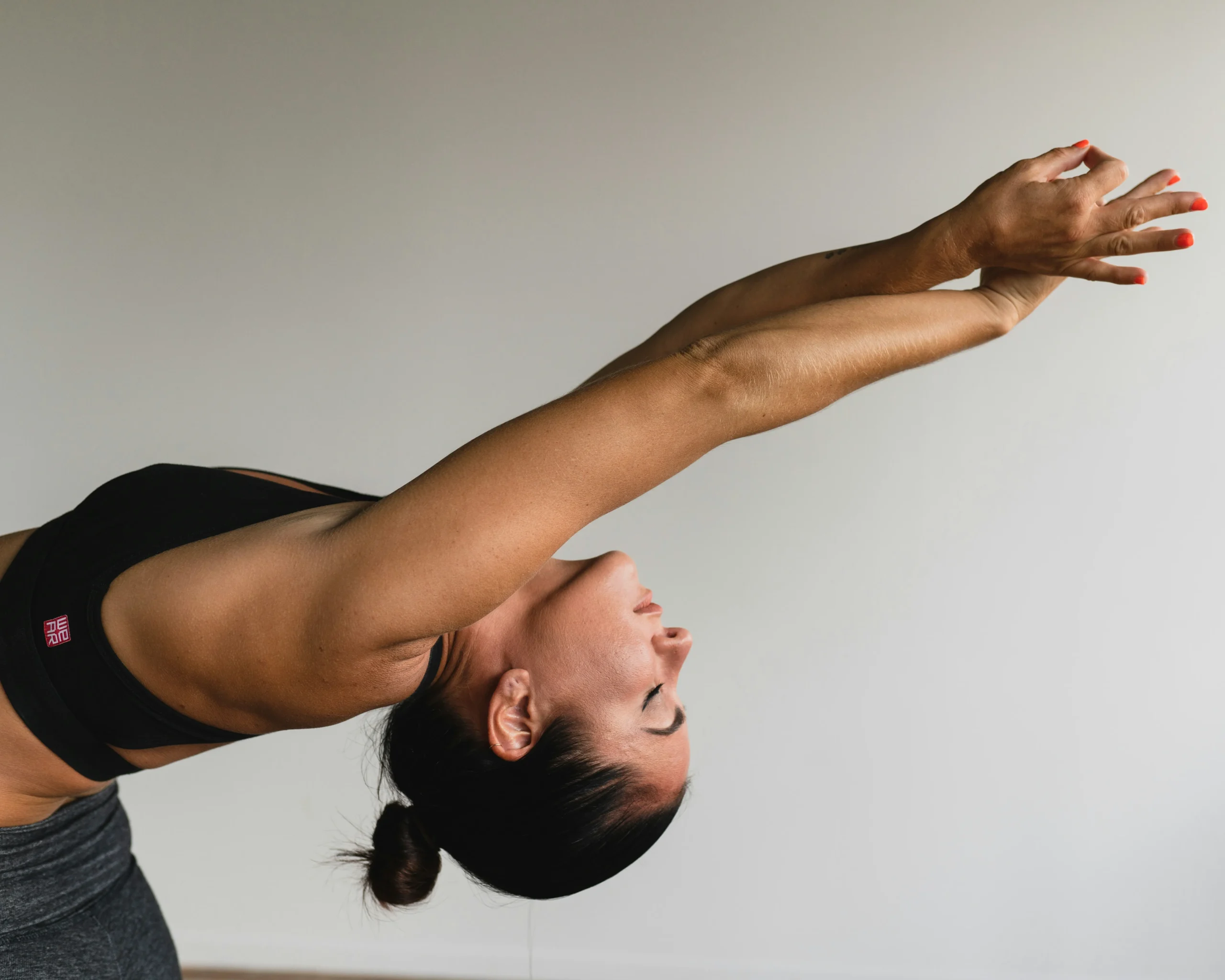Hey there, wellness warriors! 🌟 Are you ready to embark on a journey that not only keeps you fit but also brings a wave of relaxation into your hectic life? Look no further because we’ve got the ultimate guide to a basic yoga routine you can’t miss. Whether you’re a seasoned yogi or a total newbie, this routine is designed to help you stay in shape and find your zen, all from the comfort of your home.
Why is fitness and relaxation important, you ask? Well, imagine starting your day feeling energized, strong, and stress-free. Sounds like a dream, right? That’s where our basic yoga routine comes in. It’s all about striking that perfect balance between physical fitness and mental peace. Get ready to stretch, strengthen, and soothe your way to a better you!
So, grab your yoga mat, put on some comfy clothes, and let’s dive into the world of yoga magic. Trust us, this is a routine you don’t want to miss! 🌈🧘♀️
Table of Contents
Getting Started with Yoga
Alright, yoga newbies and enthusiasts alike, it’s time to get started on this amazing journey! 🧘♂️ Whether you’re here to find your inner peace or just want a fun way to stay fit, a basic yoga routine is the perfect place to begin. Let’s make sure you have everything you need to dive right in!
Essential Gear for a Basic Yoga Routine
First things first, let’s talk gear. Don’t worry, you don’t need to break the bank to get started. Here’s a quick list of essentials:
- Yoga Mat: Your trusty companion. It provides cushioning and grip, so you can nail those poses without slipping.
- Comfortable Clothing: Think stretchy and breathable. Leggings, shorts, tank tops – whatever makes you feel good.
- Optional Props: Yoga blocks and straps can be super helpful, especially for beginners who need a little extra support.
Pro tip: A water bottle and a small towel can also come in handy, especially during those sweatier sessions.
Creating a Yoga-Friendly Space at Home
Now that you’ve got your gear, it’s time to set the scene. Creating a serene, distraction-free zone for your practice is key to staying focused and relaxed. Here’s how to do it:
- Find a Quiet Spot: Choose a space where you won’t be interrupted. A corner of your living room, bedroom, or even a cozy spot in your backyard can work wonders.
- Declutter: Clear the area of any unnecessary items. A tidy space equals a tidy mind.
- Add Some Ambiance: Soft lighting, candles, or even a bit of incense can make your space feel more inviting and calming. Don’t forget some soothing background music or nature sounds.
There you have it – all set to start your yoga journey! With the right gear and a peaceful space, you’re ready to dive into your basic yoga routine and enjoy all the fabulous benefits it brings. Stay tuned for the next steps where we’ll get your body warmed up and ready to flow! 🌟✨
Warm-Up: Preparing Your Body
Before we dive into those invigorating yoga poses, let’s talk warm-up. Just like you wouldn’t jump into a sprint without a little prep, your body needs a gentle wake-up call to ease into yoga. Trust us, this step is essential to prevent injuries and maximize the benefits of your practice. Ready to get your blood flowing and muscles humming? Let’s go! 💪🧘♀️
Why Warming Up is Crucial
Imagine trying to bend a stiff, cold rubber band. Yikes, right? That’s what it’s like for your muscles if you skip the warm-up. Warming up prepares your body by increasing blood flow, loosening tight muscles, and raising your heart rate slightly. This not only enhances flexibility but also makes your yoga practice safer and more enjoyable. Plus, it sets a positive tone for the rest of your routine.
Effective Warm-Up Exercises for Yoga
Let’s get those bodies moving with some simple, effective warm-up exercises that will prepare you for your basic yoga routine. Here are our top picks:
- Neck Rolls
- Stand or sit comfortably. Slowly roll your head in a circle, gently stretching your neck. Do this for 5-10 seconds in each direction. Feel that tension melt away!
- Shoulder Shrugs
- Raise your shoulders up towards your ears, then roll them back and down. Repeat this motion for 10-15 seconds. It’s like a mini massage for your shoulders.
- Arm Circles
- Extend your arms out to the sides and make small circles, gradually making them larger. Do this for 15 seconds, then reverse the direction. Hello, mobility!
- Hip Circles
- Stand with your feet hip-width apart, hands on your hips. Slowly circle your hips in one direction for 15 seconds, then switch. This loosens up your lower back and hips.
- Cat-Cow Pose (Marjaryasana/Bitilasana)
- Start on all fours. Inhale as you arch your back (Cow Pose), exhale as you round your spine (Cat Pose). Repeat for 5-10 breaths. This dynamic move is fantastic for warming up your spine.
- Sun Salutations (Surya Namaskar)
- This sequence is a classic yoga warm-up. It involves a flow of poses like Mountain Pose, Forward Fold, Plank, Upward-Facing Dog, and Downward-Facing Dog. Perform 3-5 rounds to really get your body ready.
Feeling warm yet? These exercises will ensure your body is prepared and primed for the yoga goodness ahead. Now that we’re all loosened up, it’s time to dive into the core elements of your basic yoga routine. Get ready to flow and glow! 🌟🧘♂️
Core Elements of a Basic Yoga Routine
Welcome to the heart of your yoga journey! Now that your body is warmed up and ready to go, let’s dive into the core elements of a basic yoga routine. These foundational poses and principles will help you stay fit, relaxed, and balanced. Whether you’re aiming to build strength, increase flexibility, or simply find some peace in your day, these essentials have got you covered. 🌿🧘♀️
Importance of Combining Fitness and Relaxation
Yoga is unique because it combines physical fitness with relaxation techniques, creating a holistic approach to well-being. It’s not just about getting a workout – it’s about connecting your mind and body, finding calm amidst the chaos, and improving your overall quality of life. This balance is what makes yoga so special and effective.
Overview of Key Yoga Poses for Beginners
Let’s break down some key poses that form the backbone of any basic yoga routine. These poses are simple, effective, and perfect for beginners looking to get fit and relaxed.
There you have it – a balanced, holistic yoga routine that keeps you fit and relaxed. Ready to take the next step? Let’s explore some breathing techniques that will enhance your practice and deepen your relaxation. 🌬️🧘♂️
Essential Poses for Fitness
Ready to get strong and flexible? Let’s dive into the essential yoga poses that will help you build strength, improve balance, and enhance your overall fitness. These foundational poses are perfect for beginners and can be easily incorporated into your basic yoga routine. Get ready to feel the burn (in a good way)! 💪🧘♀️
1. Mountain Pose (Tadasana)
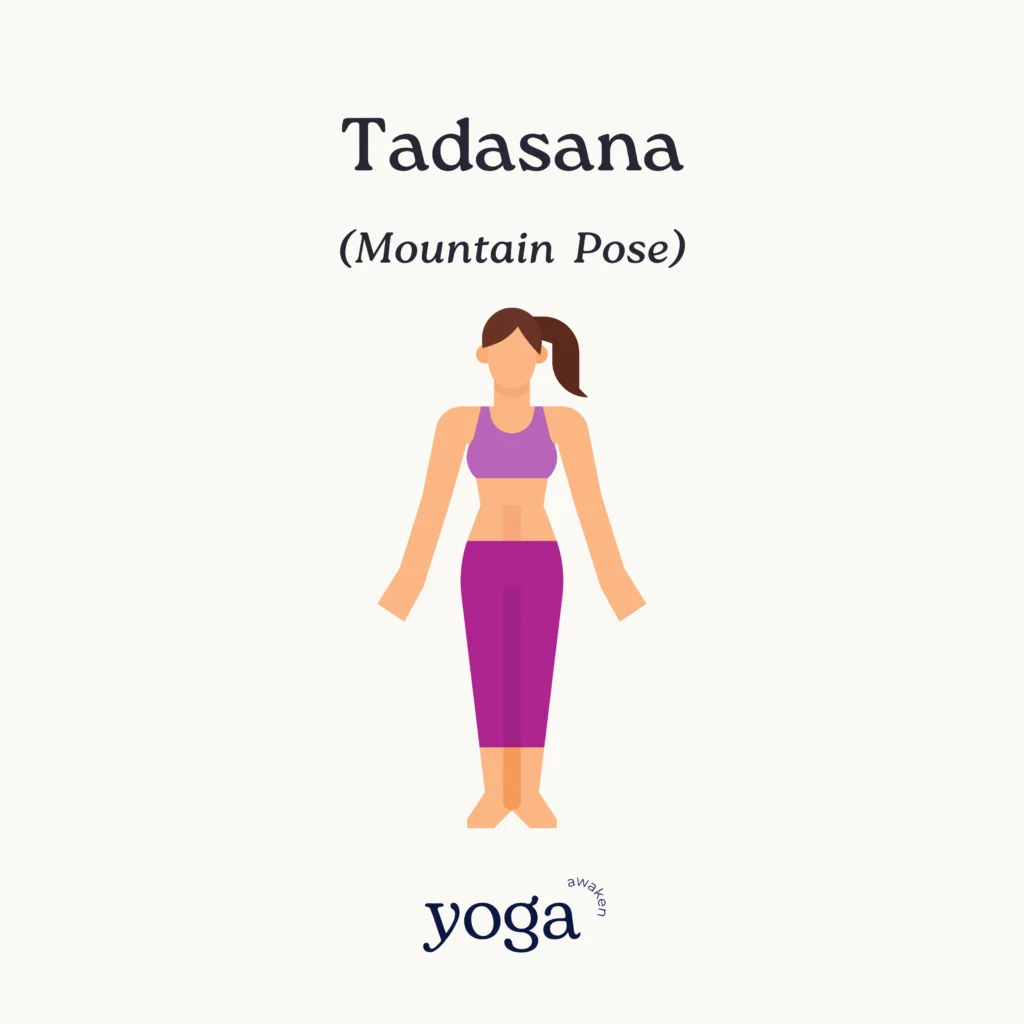
How to Do It:
- Stand tall with your feet together or hip-width apart, grounding firmly through all four corners of your feet.
- Engage your thigh muscles and lift your kneecaps.
- Lengthen your tailbone toward the floor.
- Lift your chest and let your arms hang by your sides with palms facing forward.
- Relax your shoulders away from your ears and lengthen through the crown of your head.
- Breathe deeply and hold for 5-10 breaths.
Benefits:
- Improves posture and alignment.
- Strengthens legs, core, and back muscles.
- Promotes grounding and balance.
2. Plank Pose (Phalakasana)
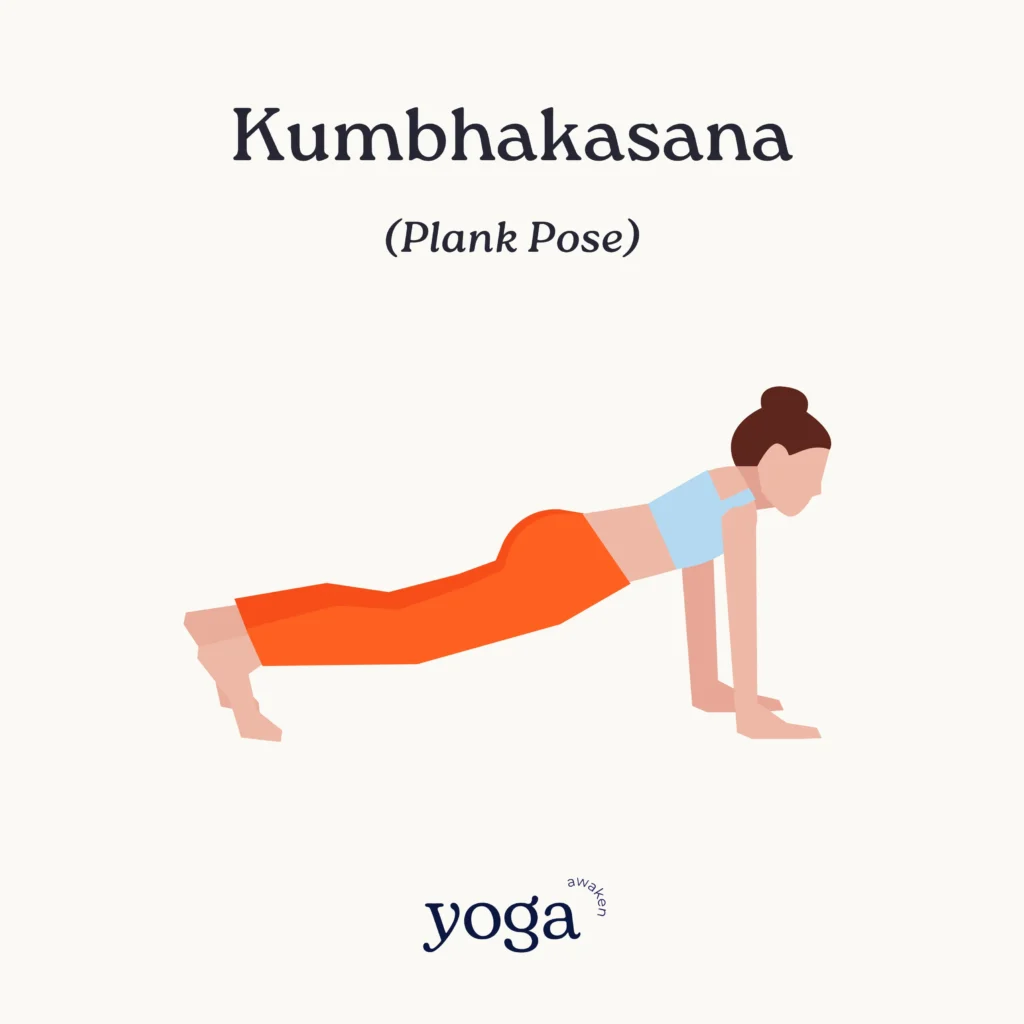
How to Do It:
- Start in a tabletop position with your hands under your shoulders and knees under your hips.
- Step your feet back one at a time, straightening your legs to form a straight line from your head to your heels.
- Engage your core, keeping your hips in line with your shoulders.
- Press through your hands and keep your shoulders directly over your wrists.
- Hold for 20-30 seconds, breathing steadily.
Benefits:
- Strengthens arms, shoulders, and core.
- Improves stability and endurance.
- Enhances overall body awareness.
3. Warrior I (Virabhadrasana I)
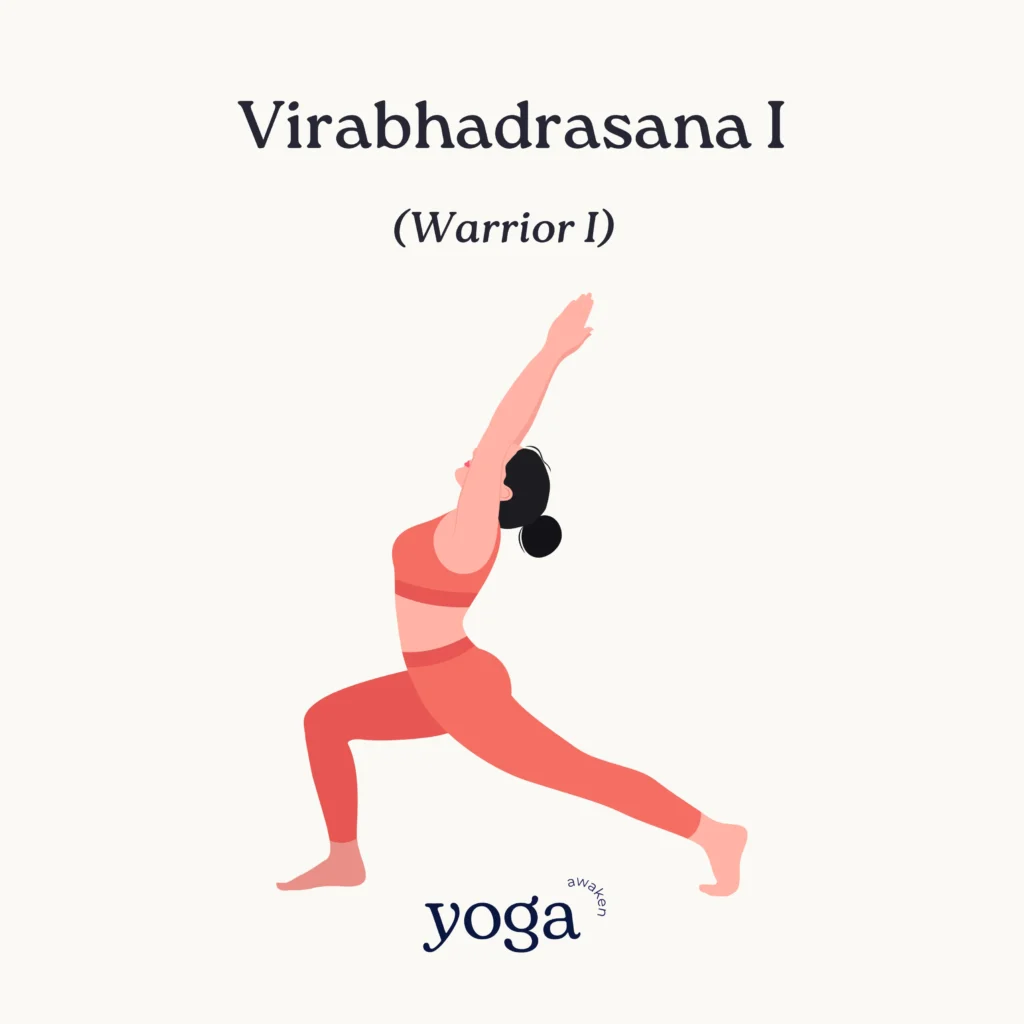
How to Do It:
- From a standing position, step your right foot forward into a lunge, bending the right knee and keeping the left leg straight.
- Turn your left foot slightly inward (about 45 degrees) and press the outer edge of the left foot into the ground.
- Square your hips to face forward.
- Raise your arms overhead, with palms facing each other or touching.
- Gaze up toward your thumbs and hold for 5-10 breaths.
- Repeat on the other side.
Benefits:
- Strengthens legs, hips, and shoulders.
- Improves balance and concentration.
- Opens the hips and chest.
4. Chair Pose (Utkatasana)
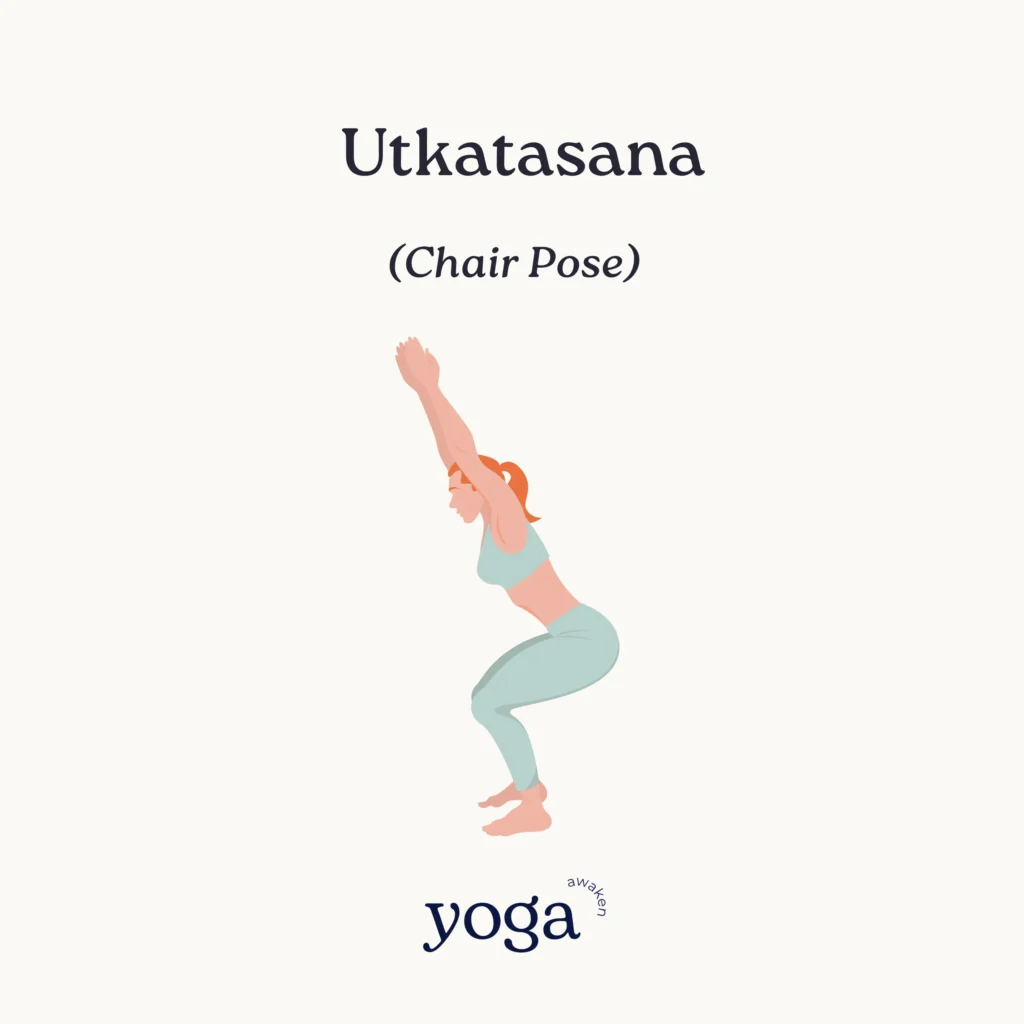
How to Do It:
- Stand with your feet together or hip-width apart.
- Bend your knees and lower your hips as if you’re sitting back into an invisible chair.
- Keep your weight in your heels and ensure your knees do not extend past your toes.
- Raise your arms overhead, keeping them parallel or bringing your palms together.
- Lengthen your spine and draw your lower belly in.
- Hold for 5-10 breaths.
Benefits:
- Strengthens thighs, calves, and ankles.
- Tones the core muscles.
- Increases stamina and endurance.
5. Downward-Facing Dog (Adho Mukha Svanasana)
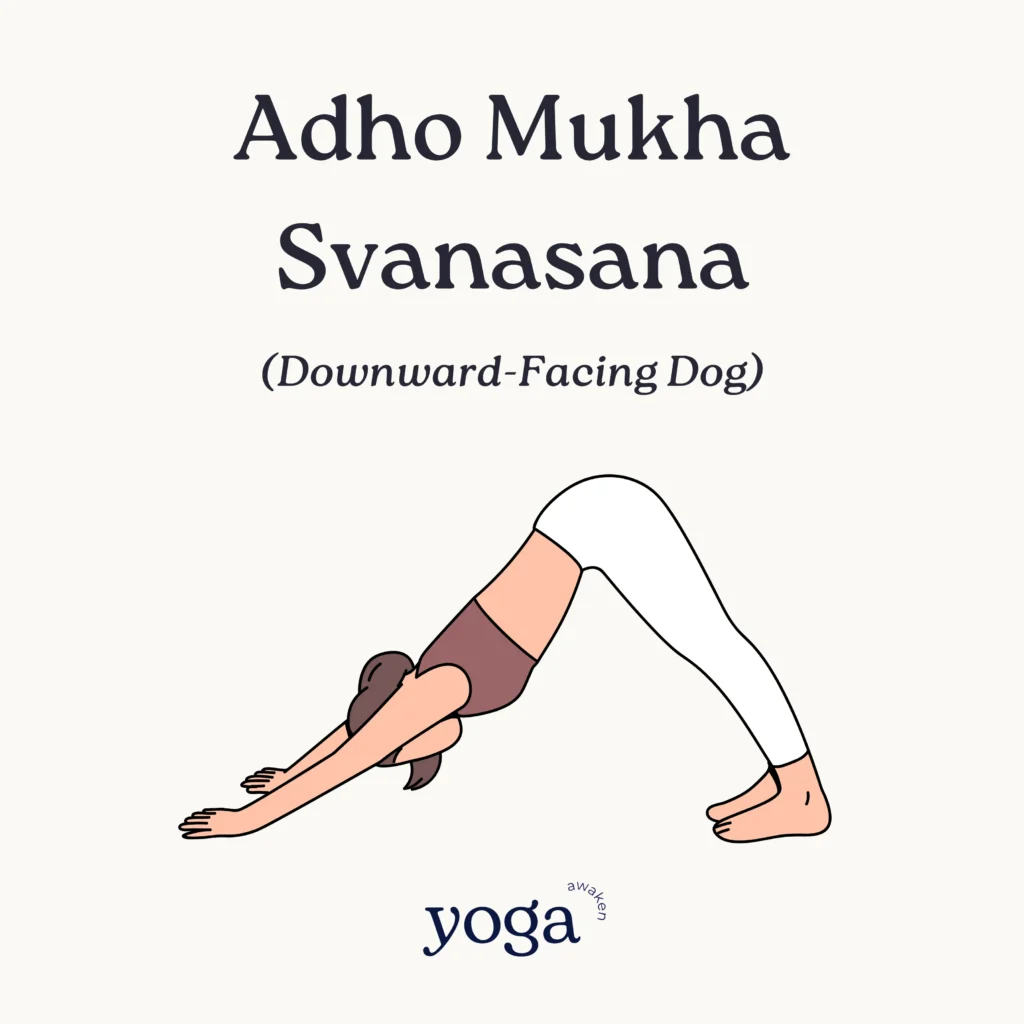
How to Do It:
- Start on all fours with your hands under your shoulders and knees under your hips.
- Tuck your toes and lift your hips up and back, straightening your legs to form an inverted V shape.
- Spread your fingers wide and press firmly through your palms.
- Relax your head between your arms and gaze toward your navel.
- Hold for 5-10 breaths, keeping your heels reaching toward the floor (they don’t have to touch).
Benefits:
- Stretches and strengthens the entire body.
- Improves flexibility in the hamstrings, shoulders, and calves.
- Relieves tension and stress.
6. Cobra Pose (Bhujangasana)
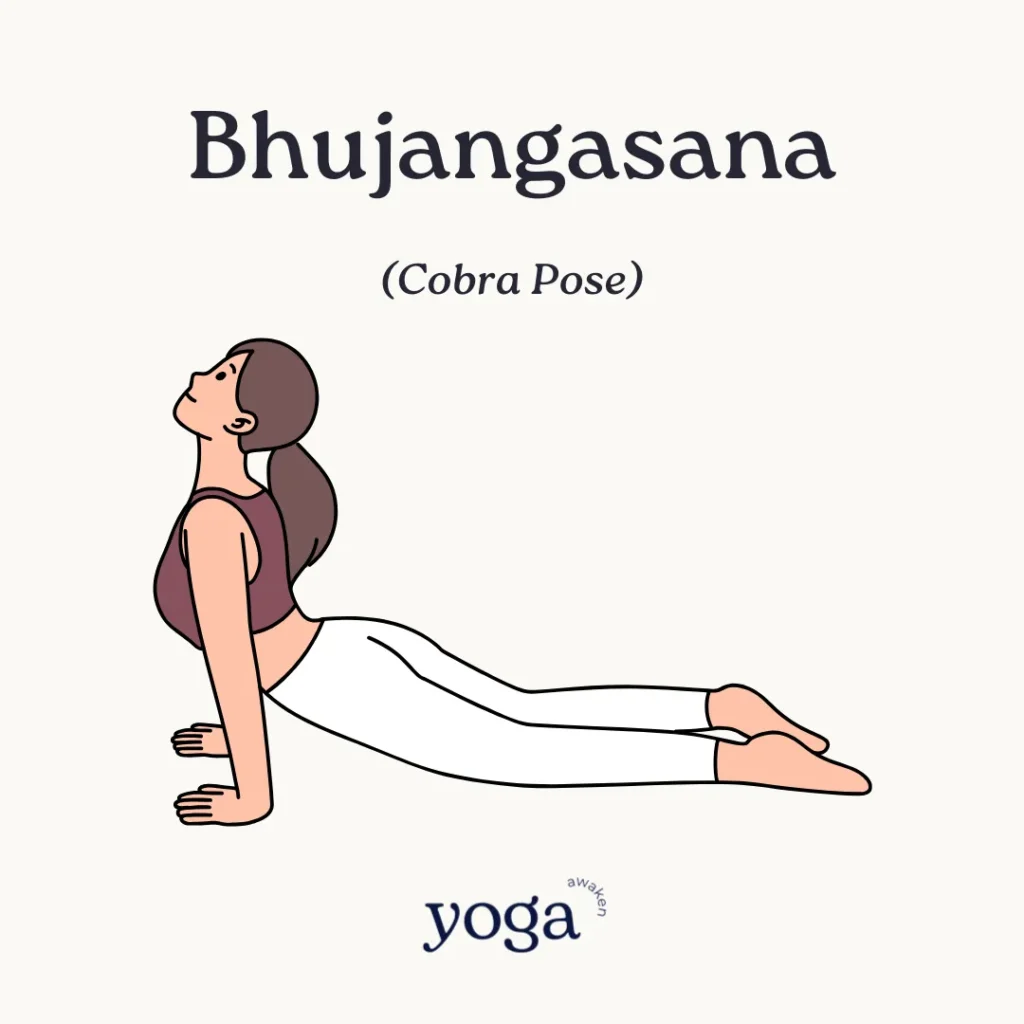
How to Do It:
- Lie face down on your mat with your legs extended behind you, tops of the feet on the floor.
- Place your hands under your shoulders, elbows close to your body.
- Press into your hands to lift your chest off the ground, keeping your elbows slightly bent.
- Roll your shoulders back and down, and lift through your sternum.
- Hold for 5-10 breaths, then slowly lower back down.
Benefits:
- Strengthens the spine and arms.
- Stretches the chest, shoulders, and abdomen.
- Improves posture and alleviates back pain.
Incorporating these essential fitness poses into your yoga routine will help you build strength, enhance flexibility, and improve your overall physical health. Now that you’re familiar with these powerful poses, let’s move on to the essential poses for relaxation to complete your balanced routine. 🌟🧘♂️
Essential Poses for Relaxation
After powering through those fitness poses, it’s time to unwind and relax. These essential relaxation poses will help you release tension, calm your mind, and promote a sense of inner peace. Perfect for cooling down and ending your yoga practice on a soothing note. Let’s get started on finding your zen! 🌙🧘♀️
1. Child’s Pose (Balasana)
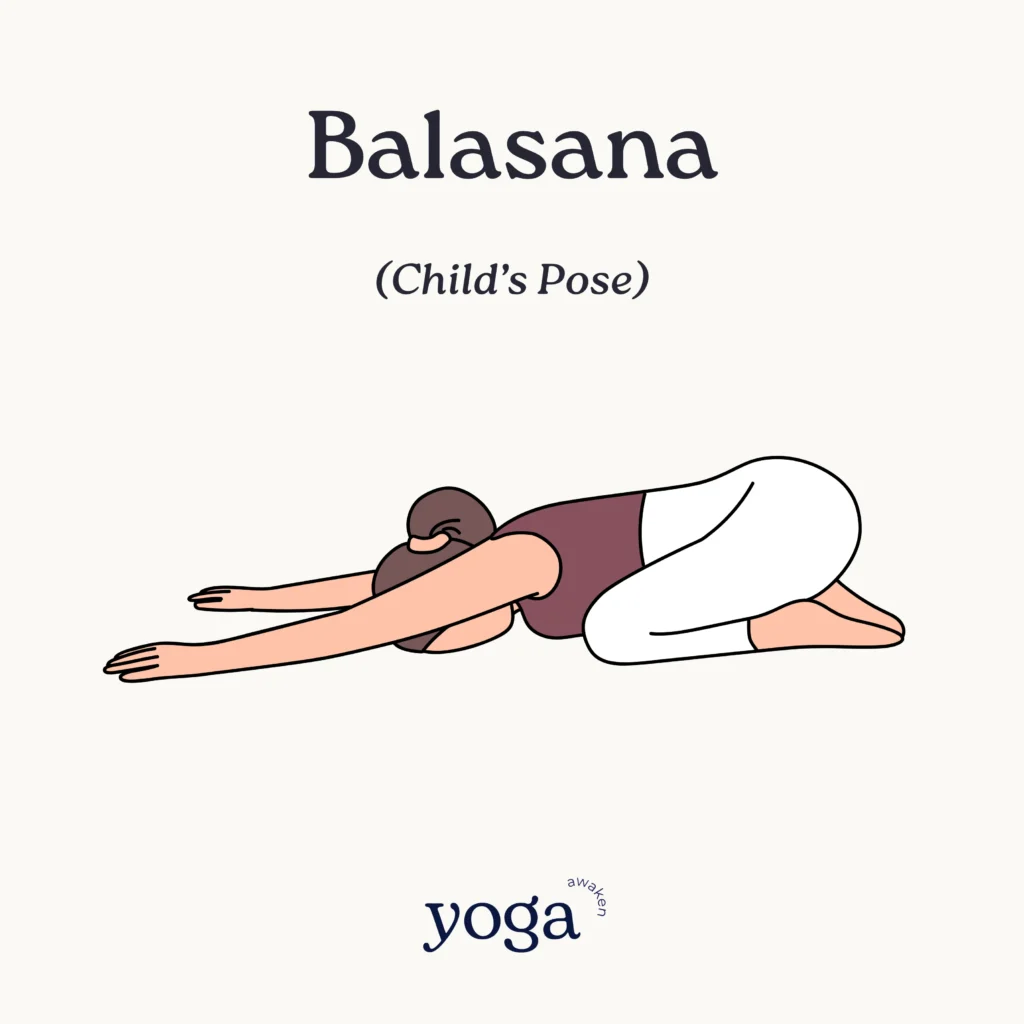
How to Do It:
- Kneel on the floor with your big toes touching and knees spread wide.
- Sit back on your heels and extend your arms forward, lowering your torso between your thighs.
- Rest your forehead on the mat and breathe deeply.
- Hold for 1-3 minutes, allowing your body to relax with each exhale.
Benefits:
- Stretches the back, hips, and thighs.
- Relieves stress and fatigue.
- Calms the mind and promotes relaxation.
2. Forward Fold (Uttanasana)
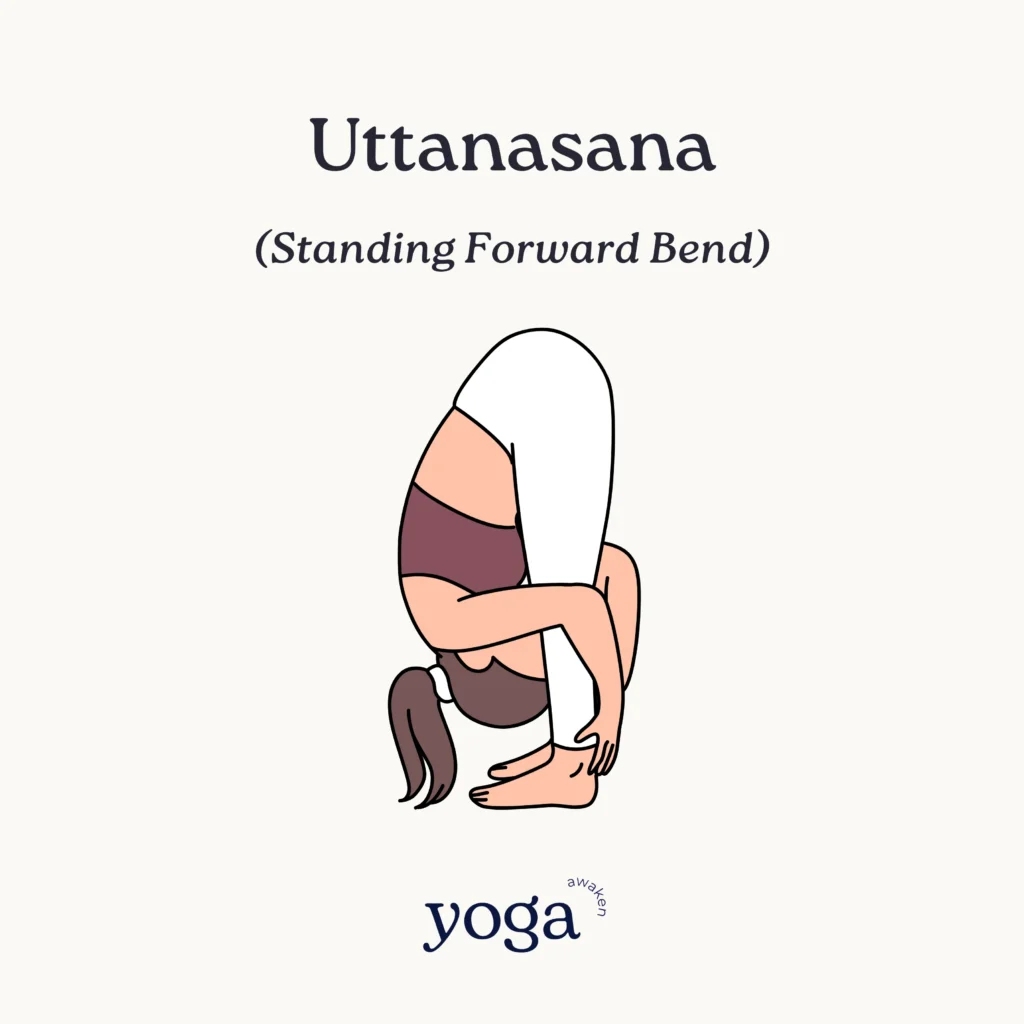
How to Do It:
- Stand with your feet hip-width apart.
- Hinge at your hips and fold forward, letting your upper body hang over your legs.
- Keep your knees slightly bent if needed.
- Hold your elbows, let your hands rest on the ground, or grab your ankles.
- Relax your neck and head, and breathe deeply for 1-2 minutes.
Benefits:
- Stretches the hamstrings, calves, and lower back.
- Reduces stress and anxiety.
- Helps to calm the mind and relieve tension.
3. Legs-Up-the-Wall Pose (Viparita Karani)
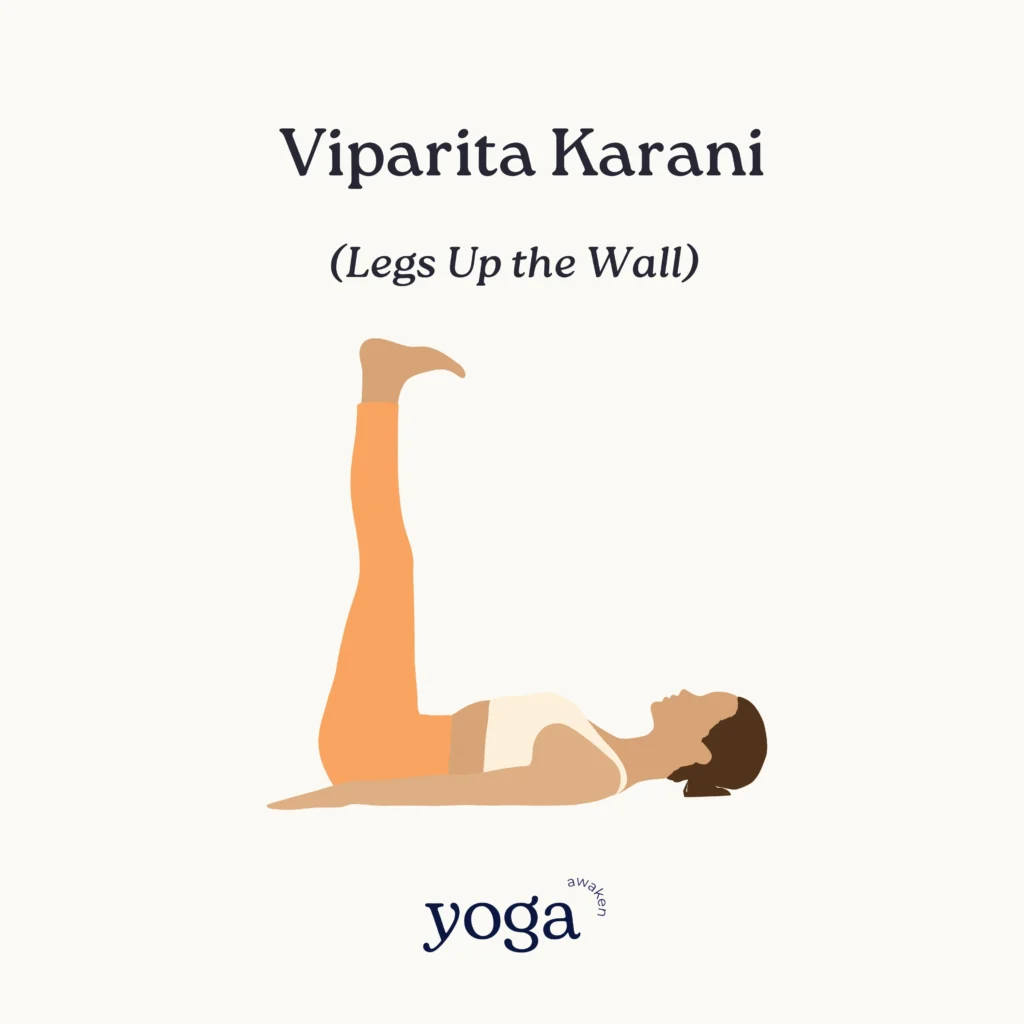
How to Do It:
- Sit with one hip against a wall, then swing your legs up onto the wall as you lie down on your back.
- Adjust your position so that your buttocks are as close to the wall as possible and your legs are straight up.
- Rest your arms by your sides, palms facing up.
- Close your eyes and breathe deeply, holding the pose for 5-10 minutes.
Benefits:
- Relieves tired legs and feet.
- Reduces swelling and improves circulation.
- Promotes relaxation and calms the nervous system.
4. Reclined Butterfly Pose (Supta Baddha Konasana)
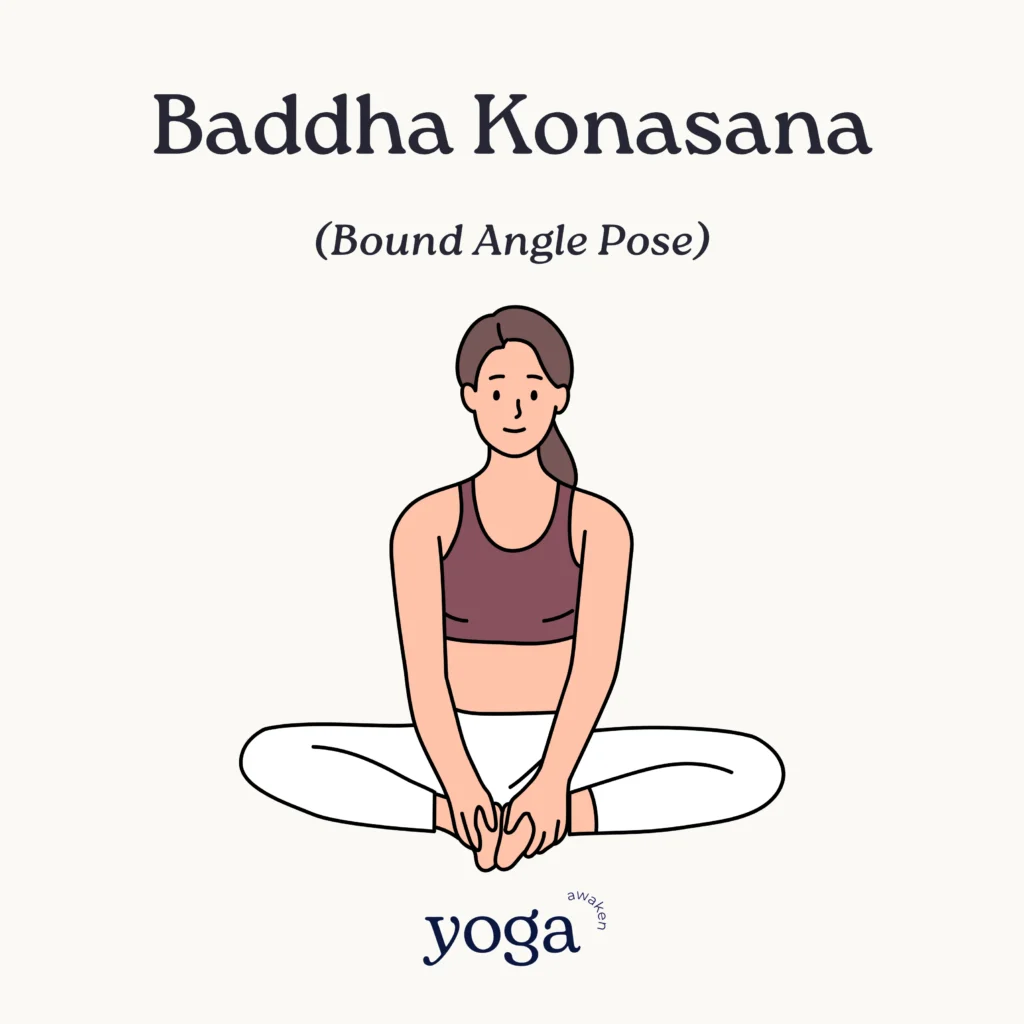
How to Do It:
- Lie on your back with your knees bent and feet on the floor.
- Bring the soles of your feet together and let your knees fall open to the sides.
- Place your arms by your sides or on your belly.
- Close your eyes and breathe deeply, holding the pose for 3-5 minutes.
Benefits:
- Opens the hips and groin.
- Reduces stress and promotes relaxation.
- Enhances blood flow to the lower abdomen.
5. Corpse Pose (Savasana)
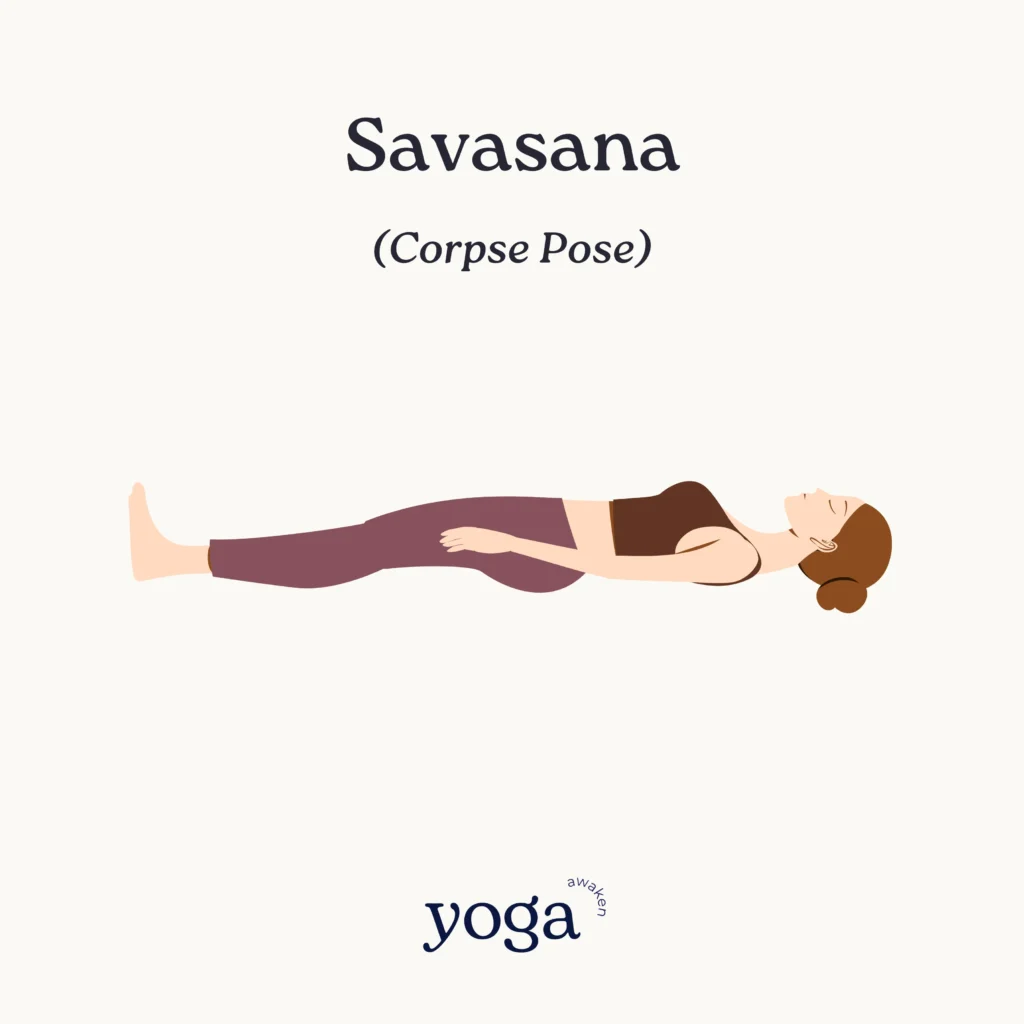
How to Do It:
- Lie flat on your back with your legs extended and arms resting by your sides, palms facing up.
- Close your eyes and take deep, slow breaths.
- Allow your entire body to relax completely, releasing any remaining tension.
- Stay in this pose for 5-10 minutes, focusing on your breath and letting go of all thoughts.
Benefits:
- Promotes deep relaxation and stress relief.
- Calms the mind and body.
- Helps to integrate the benefits of your yoga practice.
These relaxation poses are the perfect way to end your yoga session, helping you transition from your physical practice to a state of calm and tranquility. Now that you’re equipped with both fitness and relaxation poses, you’re ready to create a balanced yoga routine that keeps you fit and relaxed. Next up, let’s explore some breathing techniques to further enhance your practice. 🌟🧘♂️
Example Sequence: Blending Fitness and Relaxation Poses
Here’s a 20-30 minute sequence that integrates fitness and relaxation poses to give you a balanced yoga practice:
- Warm-Up:
- Neck Rolls: 5-10 seconds each direction
- Shoulder Shrugs: 10-15 seconds
- Arm Circles: 15 seconds each direction
- Hip Circles: 15 seconds each direction
- Cat-Cow Pose: 5-10 breaths
- Fitness Poses:
- Mountain Pose (Tadasana): 5-10 breaths
- Plank Pose (Phalakasana): Hold for 20-30 seconds
- Warrior I (Virabhadrasana I): Hold for 5-10 breaths on each side
- Chair Pose (Utkatasana): Hold for 5-10 breaths
- Downward-Facing Dog (Adho Mukha Svanasana): Hold for 5-10 breaths
- Transition to Relaxation:
- Child’s Pose (Balasana): Hold for 1-3 minutes
- Forward Fold (Uttanasana): Hold for 1-2 minutes
- Legs-Up-the-Wall Pose (Viparita Karani): Hold for 5-10 minutes
- Deep Relaxation:
- Reclined Butterfly Pose (Supta Baddha Konasana): Hold for 3-5 minutes
- Corpse Pose (Savasana): Hold for 5-10 minutes
This sequence is designed to seamlessly transition from energizing fitness poses to deeply calming relaxation poses. By alternating between these two types of poses, you ensure a comprehensive workout that benefits both your body and mind.
Tips for Maintaining Consistency
Consistency is key to reaping the benefits of your yoga practice. Here are some tips to help you stay on track:
- Set Realistic Goals: Start with short, manageable sessions and gradually increase the duration as you build strength and flexibility.
- Create a Routine: Practice at the same time each day to build a habit. Morning or evening sessions work well for many people.
- Listen to Your Body: Modify poses as needed and don’t push yourself too hard. It’s important to balance effort with ease.
- Stay Motivated: Track your progress and celebrate your milestones. Joining a yoga community or following online classes can also keep you motivated.
By combining fitness and relaxation poses, you’ll create a balanced yoga routine that supports your physical and mental well-being. Now, let’s explore some breathing techniques to further enhance your practice and deepen your relaxation. 🌿🧘♂️
Breathing Techniques for Fitness and Relaxation
Breathing is the heartbeat of yoga. It connects the body and mind, enhances your practice, and promotes overall well-being. Mastering breathing techniques can help you stay focused during challenging poses and relax deeply during restorative ones. Let’s dive into some essential breathing techniques for both fitness and relaxation. 🌬️🧘♀️
The Role of Breath in Yoga
In yoga, breath control, or pranayama, is crucial. It regulates the flow of energy throughout your body, aids in concentration, and helps manage stress. Proper breathing enhances physical performance during fitness poses and facilitates relaxation in calming poses.
Basic Breathing Exercises
Here are two fundamental breathing techniques to incorporate into your yoga routine:
1. Ujjayi Breath (Victorious Breath)
How to Do It:
- Sit comfortably or lie down in Savasana.
- Close your mouth and inhale deeply through your nose.
- Slightly constrict the back of your throat, creating a soft hissing sound as you inhale and exhale through your nose.
- Maintain a steady, even breath, focusing on the sound and sensation of your breath.
Benefits:
- Enhances focus and concentration.
- Increases oxygen intake.
- Calms the nervous system and reduces stress.
When to Use It:
- During fitness poses to maintain energy and focus.
- To transition between poses smoothly and with control.
2. Nadi Shodhana (Alternate Nostril Breathing)
How to Do It:
- Sit in a comfortable position with your spine straight.
- Use your right thumb to close your right nostril and inhale deeply through your left nostril.
- Close your left nostril with your ring finger and release your right nostril, exhaling slowly through the right nostril.
- Inhale deeply through the right nostril, then close it with your thumb and exhale through the left nostril.
- Continue this alternating pattern for 5-10 minutes.
Benefits:
- Balances the left and right hemispheres of the brain.
- Reduces stress and anxiety.
- Promotes mental clarity and focus.
When to Use It:
- Before beginning your yoga practice to center yourself.
- During relaxation poses to deepen your sense of calm.
Integrating Breathing Techniques into Your Routine
Combining these breathing techniques with your yoga practice can significantly enhance your overall experience. Here’s how to integrate them effectively:
- Start with Nadi Shodhana:
- Begin your session with 5-10 minutes of Nadi Shodhana to balance and calm your mind. This sets a peaceful tone for your practice.
- Use Ujjayi Breath During Fitness Poses:
- Maintain Ujjayi breath throughout your fitness poses to stay focused and energized. The steady rhythm of your breath will help you move gracefully from one pose to the next.
- Return to Nadi Shodhana or Gentle Breathing During Relaxation:
- As you transition to relaxation poses, switch to gentle breathing or return to Nadi Shodhana to deepen your relaxation and release any remaining tension.
By incorporating these breathing techniques, you’ll find that your yoga practice becomes more mindful and effective. Breath control not only supports physical movements but also enhances mental clarity and emotional balance.
Now that you’ve got the breathing techniques down, let’s move on to some tips for maintaining consistency in your yoga practice. Stay tuned to keep your routine sustainable and enjoyable! 🌟🧘♂️
Tips for Maintaining Consistency
Consistency is the secret sauce to unlocking the full benefits of yoga. Whether you’re aiming to build strength, increase flexibility, or find inner peace, sticking to a regular practice is key. Here are some practical tips to help you maintain a consistent yoga routine and make it a lasting part of your life. 🌟🧘♀️
1. Set Realistic Goals
Start small and set achievable goals. Whether it’s 10 minutes a day or three sessions a week, choose a frequency that fits your lifestyle. As you build the habit, you can gradually increase the duration and intensity of your practice.
2. Create a Routine
Consistency thrives on routine. Try to practice yoga at the same time each day. Morning yoga can energize your day, while evening sessions can help you unwind. Find a time that works best for you and stick to it.
3. Make It Enjoyable
Choose poses and sequences that you enjoy. If your practice feels like a chore, it’s harder to stay motivated. Mix it up with different styles of yoga, and incorporate music, candles, or incense to make your practice more enjoyable and relaxing.
4. Track Your Progress
Keep a yoga journal to track your progress. Note down the poses you’ve practiced, any improvements, and how you feel after each session. This can be incredibly motivating and helps you see how far you’ve come.
5. Set Up a Yoga Space
Create a dedicated space for your practice. It doesn’t have to be big – just a quiet, clutter-free area where you can lay out your mat and feel at ease. Having a special spot for yoga can make it easier to get into the right mindset.
6. Use Online Resources
Take advantage of online classes, apps, and videos. There are countless resources available that can provide guidance, inspiration, and structure. Following along with an instructor can keep you motivated and ensure you’re practicing correctly.
7. Join a Yoga Community
Engage with a yoga community, whether it’s a local class, an online group, or a social media community. Sharing your experiences and learning from others can provide support, encouragement, and a sense of accountability.
8. Listen to Your Body
It’s important to listen to your body and practice mindfully. Avoid pushing yourself too hard and take rest days when needed. Yoga is about balance, and overexertion can lead to burnout or injury.
9. Celebrate Your Milestones
Acknowledge and celebrate your progress. Whether it’s mastering a new pose, improving your flexibility, or simply sticking to your routine for a month, celebrating these achievements can boost your motivation.
10. Stay Inspired
Keep your practice fresh and exciting by exploring new poses, styles, and challenges. Read books on yoga, watch inspiring videos, or attend workshops. Staying inspired helps maintain your enthusiasm for your practice.
By incorporating these tips into your routine, you’ll find it easier to maintain consistency and enjoy all the benefits that yoga has to offer. Remember, yoga is a journey, not a destination. Embrace each step of the process and enjoy the positive changes it brings to your life.
Ready to adapt your routine as you progress? Let’s explore how to adjust and enhance your yoga practice over time. 🌿🧘♂️
Adapting Your Routine Over Time
As you grow in your yoga practice, it’s essential to adapt and evolve your routine to keep things fresh, challenging, and beneficial. Whether you’re looking to deepen your practice, explore new styles, or address changing fitness goals, here are some tips on how to adapt your yoga routine over time. 🌿🧘♀️
1. Listen to Your Body
Your body’s needs can change daily. Some days you might feel energized and ready for a challenging practice; other days, a gentle, restorative session might be more appropriate. Always listen to your body and adjust your practice accordingly.
2. Gradually Increase Intensity
As you become more comfortable with your basic routine, start incorporating more challenging poses. Introduce poses that require greater strength, flexibility, or balance. For example, if you’ve mastered the Warrior I pose, try progressing to Warrior III.
3. Explore Different Styles of Yoga
Dabble in various yoga styles to keep your practice interesting and well-rounded. Here are a few styles to consider:
- Vinyasa: A dynamic flow linking breath with movement.
- Ashtanga: A rigorous style following a specific sequence of poses.
- Yin: Focuses on deep, passive stretches held for longer periods.
- Restorative: Uses props to support the body in relaxing poses.
- Power Yoga: A high-intensity practice that builds strength and endurance.
4. Incorporate Advanced Poses
Once you’re comfortable with the basics, start integrating advanced poses into your practice. Here are a few to try:
- Crow Pose (Bakasana): A foundational arm balance.
- Headstand (Sirsasana): An inversion that requires strength and control.
- Wheel Pose (Urdhva Dhanurasana): A deep backbend that opens the chest and shoulders.
- Half Moon Pose (Ardha Chandrasana): A balancing pose that strengthens the legs and core.
5. Focus on Alignment and Technique
As you advance, pay closer attention to your alignment and technique. Small adjustments can make a big difference in the effectiveness and safety of your practice. Consider taking a few classes with a certified instructor to get personalized feedback.
6. Add Pranayama and Meditation
Deepen your practice by incorporating pranayama (breath control) and meditation. These practices enhance mental clarity, reduce stress, and improve your overall yoga experience. Start with simple techniques like Ujjayi breath and seated meditation, then explore more advanced practices over time.
Read more about What is Pranayama? The Ultimate Joy of Purifying Breath Technique for Beginners
7. Set New Goals
Setting new goals can keep you motivated and focused. Whether it’s mastering a challenging pose, increasing your practice duration, or incorporating a daily meditation practice, having clear goals helps guide your yoga journey.
8. Use Props for Deeper Stretches
Props like blocks, straps, and bolsters can help you access deeper stretches and more advanced poses safely. They provide support and allow you to maintain proper alignment, which is crucial as you progress.
9. Monitor Your Progress
Keep a journal or use a yoga app to track your progress. Documenting your practice helps you see improvements over time and identify areas that need more focus. It’s also a great way to stay motivated and celebrate your achievements.
10. Stay Curious and Keep Learning
Yoga is a lifelong journey of learning and self-discovery. Stay curious and open to new experiences. Read books, attend workshops, and learn from various teachers to expand your knowledge and keep your practice vibrant and engaging.
By continuously adapting your yoga routine, you’ll ensure that it remains challenging, rewarding, and aligned with your personal growth. Ready to tackle common mistakes and make the most of your practice? Let’s dive into some pitfalls to avoid and how to overcome them. 🌟🧘♂️
Conclusion
Congratulations, yogis! You’ve now got a comprehensive guide to building and maintaining a basic yoga routine that keeps you both fit and relaxed. By integrating fitness and relaxation poses, mastering essential breathing techniques, and adapting your routine over time, you’re well on your way to a balanced, enriching yoga practice.
Remember, consistency is key. Set realistic goals, create a dedicated space, and make your practice enjoyable. Listen to your body, stay motivated, and celebrate your milestones. Whether you’re starting your journey or deepening your practice, the most important thing is to enjoy the process and the positive changes it brings to your life.
With this balanced approach, you’ll not only enhance your physical fitness but also cultivate inner peace and mental clarity. So, roll out your mat, take a deep breath, and embrace the transformative power of yoga. Namaste! 🌟🧘♀️
Stay tuned for more tips and insights to make the most of your yoga journey. Keep practicing, stay curious, and let your yoga routine be a source of joy and wellness in your life. 🌿🧘♂️
For further blogs, visit Yoga Sequences for Beginners.

